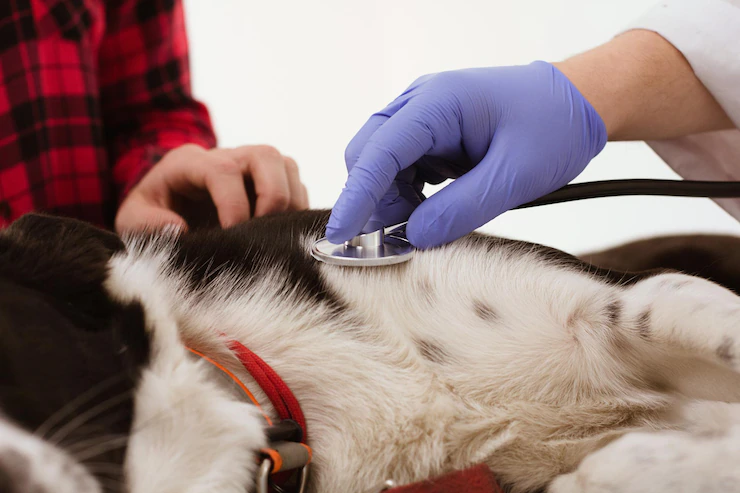What is Addison’s disease?: Symptoms, Causes and Treatment

Addison’s disease, also known as hypoadrenocorticism, is the common name for lower hormone production from the outer part of the adrenal gland. Lets discuss the causes and symptoms of Addison’s disease
Arguably the two most important hormones produced by the adrenal glands are cortisol and aldosterone, which play a significant role in regulating your dog’s internal system and other body functions. For many pets, diet becomes less and less varied and changes to a much simpler food. Without fiber in their diet, the body starts to deteriorate. This then leads to serious complications like constipation or diarrhea, weight loss or gain, ectoparasites (fleas and ticks), headaches, and even death.
Table of contents
Adrenal glands
The adrenal gland is a small, paired gland located near the kidneys. They’re responsible for producing two hormones that regulate several necessary bodily functions and are crucial for survival
Two important hormones are cortisol and aldosterone. This help regulate the body’s levels of sodium and potassium – both necessary for proper fluid balance.
What causes Addison’s disease?
Addison’s disease symptoms in dogs is a result of the body’s immune system attacking the adrenal glands. It may be caused by trauma, infection, or cancer but less frequently. A complication following the treatment of hyperadrenocorticism (increased production of cortisol and aldosterone) is Addison’s disease, which also occurs when not enough cortisol and aldosterone are produced.
If you are using a medication to treat Cushing’s disease, it might inadvertently suppress too much adrenal gland activity or permanently damage the gland. This could lead to deficiencies of cortisol and aldosterone.

One form of Addison’s Disease can result from a tumor or defect of the pituitary gland, an important hormone regulator in your brain. Secondary Addison’s disease can occur in dogs if they have been on long-term steroids and when they stop taking medication suddenly. This is iatrogenic hypoadrenocorticism, and it usually resolves by itself after a few days
Certain dog breeds seem to be at increased risk for developing Addison’s disease. These include but are not in limits to Portuguese Water Dogs, Bearded Collies, Standard Poodles, Nova Scotia Duck Tolling Retrievers, Leonbergers Great Danes, and Labrador.
Symptoms of Addison’s Disease in Dogs
The symptoms of Progressive Addison’s disease are often so similar to those of other diseases that the disorder can be difficult to diagnose. Overall, symptoms of Addison’s may include food and water refusal, weight loss, and decreased responsiveness to other illnesses. It is also important to point out that the semblances of Addison’s disease can vary in severity.
Reduced aldosterone production can impact your body in many ways-signs include changes in sodium, potassium, and chloride. This can lead to kidney problems and heart issues.
Cortisol, the other major steroid hormone affected by Addison’s, plays an important role in virtually every dog’s tissues. Regular exercise regulates the production of glucose, regulates metabolism, and influences the breakdown of fat and proteins, and blood pressure. It also counteracts inflammation and stimulates the formation of red blood cells.
The majority of DDAH-producing disorder manifests in the form of lower cortisol, which can cause pets to have problems regulating body temperature. They may also feel lethargic and experience confusion.
Addison’s disease: Symptoms
Many common symptoms of Addison’s disease are hard to identify, but if you know what to look for, it can be easier. Common symptoms can include: weight loss, feeling weak and tired all the time, increased appetite, and nausea.
- Lethargy
- Anorexia (lack of appetite)
- Weight loss
- Vomiting, Diarrhea &Bloody stools
- Hair loss
- Increased urination
- Increased thirst
- Dehydration
- Cardiac Conditions such as Weak pulse or Irregular heart rate
- Low temperature
- Painful abdominal pain
- Hypoglycemia
How is Addison’s disease diagnosed?
Diagnosis is based on your pet’s medical history, including any medications and clinical signs. Results of common blood and urine tests are also significant. You should be especially aware of electrolyte imbalances. The most definitive test for Addison’s Disease symptoms is the ACTH- stimulation test. After getting a synthetic form of ACTH injected, cortisol levels are tested and compared to before.

You might have to arrange for a few more tests such as basal cortisol levels, natural plasma ACTH, electrocardiogram (ECG), radiographs (X-rays), or abdominal ultrasound. These are all considered ‘routine’ in these types of cases. In rare instances, MRI or CT may also need to be performed.
Addison’s disease: Treatment
There are many ways in which dogs with the disease can be successfully treated.
DOCP is an FDA-approved medication for treating Addison’s disease in dogs. Additionally, this drug injects into the body every 3–6 weeks, depending on the patient, and replaces that mineralocorticoid aldosterone we all need in our lives. It’s often supplemented with an oral glucocorticoid and with a bit of training it can be given at home.
DOCP is not suitable for all dogs, and some of Addison’s patients do best on medications that replace both the mineralocorticoid and the glucocorticoid hormones such as fludrocortisone.
Although changes in diet and activity are usually necessary to lower your dog’s risk of an Addisonian crisis, the majority of dogs return to a normal life, even after experiencing an Addisonian crisis. Your veterinarian will discuss the treatment options with you and decide which therapy is best for your dog.
Takeaway
Detecting Addison’s disease in dogs can be difficult, and treatment options vary depending on the symptoms. Your veterinarian should be able to help you detect the problem – this article is not a replacement for veterinary advice. If you suspect that your dog might have Addison’s disease, or if Addisonian crisis symptoms are present please call your veterinarian.
Prednisone is a potentially powerful drug, and while it can be helpful in the short term, it can have complex side effects. Without following your vet’s instructions about how to use the drug on your dog, you run the risk of serious medical complications like Addison’s disease.
Products That We Suggest for you
PET BOUNCE- Pet Supplement
ALL-NATURAL PET BOUNCE™ CONTAINS HOMEOPATHIC INGREDIENTS TRADITIONALLY USED TO HELP RELIEVE PAINFUL ARTHRITIS SYMPTOMS
To know more and purchase, Click Here








Comment to this Article
Comments that encourage respectful conversation are welcomed at AGP Health n Beauty. Stay on subject, please. Comments that are aggressively promotional of goods or services or that include personal attacks, vulgar language, or other forms of abuse will be deleted. Which remarks break our comment policy will be decided at our discretion. (Anonymous comments are accepted; just leave out your name in the comment box. Although necessary, your email address won't be posted with your comment.)